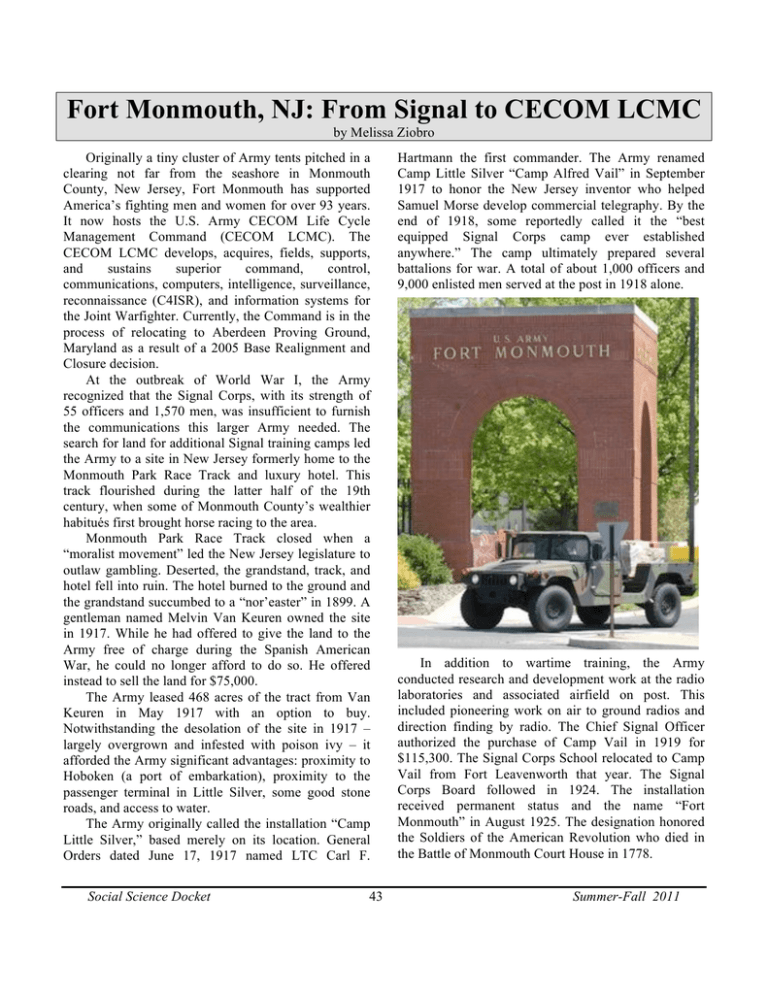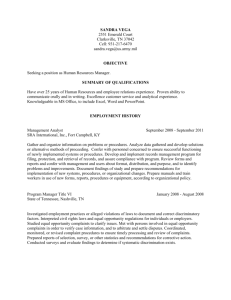Fort Monmouth, NJ: From Signal to CECOM LCMC
advertisement

Fort Monmouth, NJ: From Signal to CECOM LCMC by Melissa Ziobro Originally a tiny cluster of Army tents pitched in a clearing not far from the seashore in Monmouth County, New Jersey, Fort Monmouth has supported America’s fighting men and women for over 93 years. It now hosts the U.S. Army CECOM Life Cycle Management Command (CECOM LCMC). The CECOM LCMC develops, acquires, fields, supports, and sustains superior command, control, communications, computers, intelligence, surveillance, reconnaissance (C4ISR), and information systems for the Joint Warfighter. Currently, the Command is in the process of relocating to Aberdeen Proving Ground, Maryland as a result of a 2005 Base Realignment and Closure decision. At the outbreak of World War I, the Army recognized that the Signal Corps, with its strength of 55 officers and 1,570 men, was insufficient to furnish the communications this larger Army needed. The search for land for additional Signal training camps led the Army to a site in New Jersey formerly home to the Monmouth Park Race Track and luxury hotel. This track flourished during the latter half of the 19th century, when some of Monmouth County’s wealthier habitués first brought horse racing to the area. Monmouth Park Race Track closed when a “moralist movement” led the New Jersey legislature to outlaw gambling. Deserted, the grandstand, track, and hotel fell into ruin. The hotel burned to the ground and the grandstand succumbed to a “nor’easter” in 1899. A gentleman named Melvin Van Keuren owned the site in 1917. While he had offered to give the land to the Army free of charge during the Spanish American War, he could no longer afford to do so. He offered instead to sell the land for $75,000. The Army leased 468 acres of the tract from Van Keuren in May 1917 with an option to buy. Notwithstanding the desolation of the site in 1917 – largely overgrown and infested with poison ivy – it afforded the Army significant advantages: proximity to Hoboken (a port of embarkation), proximity to the passenger terminal in Little Silver, some good stone roads, and access to water. The Army originally called the installation “Camp Little Silver,” based merely on its location. General Orders dated June 17, 1917 named LTC Carl F. Social Science Docket 43 Hartmann the first commander. The Army renamed Camp Little Silver “Camp Alfred Vail” in September 1917 to honor the New Jersey inventor who helped Samuel Morse develop commercial telegraphy. By the end of 1918, some reportedly called it the “best equipped Signal Corps camp ever established anywhere.” The camp ultimately prepared several battalions for war. A total of about 1,000 officers and 9,000 enlisted men served at the post in 1918 alone. In addition to wartime training, the Army conducted research and development work at the radio laboratories and associated airfield on post. This included pioneering work on air to ground radios and direction finding by radio. The Chief Signal Officer authorized the purchase of Camp Vail in 1919 for $115,300. The Signal Corps School relocated to Camp Vail from Fort Leavenworth that year. The Signal Corps Board followed in 1924. The installation received permanent status and the name “Fort Monmouth” in August 1925. The designation honored the Soldiers of the American Revolution who died in the Battle of Monmouth Court House in 1778. Summer-Fall 2011 The Signal Corps’ Electrical Laboratory of Washington and the Signal Corps’ Research Laboratory of New York merged with the Radio Laboratories at Fort Monmouth in 1929 to form the consolidated “Signal Corps Laboratories.” The scientists of these labs developed the first U.S. aircraft detection radar, among many other things, during the inter war period. The outbreak of WWII in Europe significantly impacted Fort Monmouth. The Army was immediately authorized additional personnel. The Signal Corps School curriculum changed to accommodate the increased enrollment. Then, with the passage of the Selective Service Act, the Chief Signal Officer ordered a Replacement Training Center at Fort Monmouth for enlisted personnel. During the 30 months of its existence, the Eastern Signal Corps Replacement Training Center produced more than 60,000 Signal Corps specialists. Fort Monmouth’s other wartime training focused on officer candidates. The Officer Candidate Department activated within the Signal Corps School on June 2, 1941 and the first class commenced with 490 students. Subsequent classes peaked at about 1,000 men per class. Fort Monmouth laboratory development during this period included work on an early FM backpack radio that provided front line troops with reliable, static free communications. FM radio relay and radar, both products of the labs at Fort Monmouth, are often rated among the top weapon systems that made a difference in World War II. Wartime training subsided quickly after the cessation of hostilities. The Army abandoned many expansion facilities leased or purchased during the war to accommodate increased training missions. The Fort’s research and development continued unabated, however. The Evans Signal Laboratory outpost in Wall Township, NJ witnessed a milestone in scientific history in 1946 when Signal Corps scientists successfully bounced electronic signals off the moon. Other post-WWII era accomplishments included work on weather radar and communication and weather satellites. Advancements in communications systems came so far that in 1957 the Army discontinued the pigeon service, a fixture on post since the end of WWI. Fort Monmouth sold many homing pigeons at auction, while “hero” pigeons with distinguished service records retired to zoos. Social Science Docket 44 The 1960s brought changes to Fort Monmouth even bigger than the end of the pigeon service. The Army established the Electronics Command (ECOM) at Fort Monmouth in 1962. This marked the beginning of the end of Fort Monmouth’s reign as the “Home of the Signal Corps.” ECOM, would handle most of the logistics and research and development functions that formerly belonged to the Office of the Chief Signal Officer. At that time, this included a work force of 14,000 people and a budget of $760 million. The training mission that had been at Fort Monmouth since its inception would ultimately move to Fort Gordon, Georgia as a result of this reorganization. ECOM supplied combat troops with a number of high-technology commodities during the Vietnam conflict. These included mortar locators, night vision devices, and surveillance systems. Personnel from this organization worked round the clock during the Gulf War to equip soldiers with everything from jammers to night vision, to surveillance and intelligence systems, and to sustain these systems in the field. A March 1991 Newsweek article said of the Fort Monmouth-managed Firefinder radars, “When an Iraqi Battery fired a round, a U.S. Army Q-37 radar would sight it and feed the battery’s coordinates to computers that directed the American guns. It took less than a minute to drop a counter-round on the Iraqis. Many of them soon stopped firing. To pull the lanyard was to invite death.” Support for the troops continues today. The team headquartered at Fort Monmouth intensively manages some 128 major defense programs, amounting to over $10 billion in total obligation authority to acquire, field, and provide new equipment training. The CECOM LCMC team is responsible for almost half the Army’s inventory of end items and spare parts. Summer-Fall 2011




